- Good Sam Community
- Groups
- Travel Trailer Group
- Forum
- Cleaning an epdm roof
- Subscribe to RSS Feed
- Mark Topic as New
- Mark Topic as Read
- Float this Topic for Current User
- Bookmark
- Subscribe
- Mute
- Printer Friendly Page
Cleaning an epdm roof
- Mark as New
- Bookmark
- Subscribe
- Mute
- Subscribe to RSS Feed
- Permalink
- Report Inappropriate Content
Oct-10-2017 03:42 AM
- Mark as New
- Bookmark
- Subscribe
- Mute
- Subscribe to RSS Feed
- Permalink
- Report Inappropriate Content
Oct-18-2017 07:26 AM
MKirkland wrote:
You guys really have got the roof subject down to a science. For me, I have had my trusted dealer wash and exam the roof for the last two years. I bought the trailer in 2011 new.The dealer took pics of the roof each year and we would discuss if anything should be done. In the past years we decided the cracks were not bad enough. This year was different. We went ahead with repairs. The sun can get pretty brutal where we live.They took off the old caulking and then used a tube of lap sealant W leveling, and a lap sealant white non leveling. These are Dicor products.It took them just under 4 hours.The cost was around $500.
Hi MKirkland,
Good for you!!! We congratulate you for knowing and doing something to help protect your camper roof system. You now join the small percentage that do "something" to help protect their camper roof.
Curios, do you know if the dealer washes the roof each year before inspecting it?
Yes, as you can see, some of "us" are passionate about our campers and taking care of them. Diesel verses gas, do you need a WD hitch, tires, holding tank chemicals etc. and now maybe do you wash your RV roof... are topics of passion. We do get into it! 🙂
Thanks
John
- Mark as New
- Bookmark
- Subscribe
- Mute
- Subscribe to RSS Feed
- Permalink
- Report Inappropriate Content
Oct-18-2017 07:20 AM
Huntindog wrote:
John. as I stated from my post many many years ago, Dicors position on roof cleaning only changed after repeated customer requests on how to do this... Probably because of the harmless black streaks that some get. ( Here in AZ, it doesn't seem to be an issue).
Dicor obviously saw a business opportunity, and created a line of roof cleaning products. Which they now naturally strongly recommend.
As for different thicknesses. That may now be the case. But it doesn't change much.
Likely the RV manufacturers asked for lighter material so they could reduce the weight of their units.
Carlise says that the white material CAN be washed. Only to retain the reflectitiy of the material. But there is NO warranty requirement for it. AND the black material has NO washing recommendations.
For those that want to wash your roof.. My recommendation stays the same. If it makes you feel good, do it. So long as it is done right,
it won't hurt a thing....
But since I became the Safety Coordinator at my job about 5 years ago.... I must caution people on the dangers of doing so. A wet roof can be VERY slippery! The only safe way to do it would be with a catwalk scaffold system. Some dealers may have such a system. I know the manufacturer does, as I have seen it.
A fall to the ground can SERIOUSLY cripple or kill.
Be careful up there.
Hi Huntingdog,
Your note just triggered a few thoughts.
The weather conditions in AZ are very different then back east. My observations on dirt and molded roofs are coming from OH,
PA, NY, MI, NJ, NH, MD, IN for the most part on roofs that I myself have seen or worked on. I have worked out of our Casa Grande AZ (outside Phoenix) for many years. The joke is for us back east, "its a dry heat"... They dry season is long and dry. The wet season is shorter. Back east, mold grows all over. The side of houses, asphalt roofs etc. That slime holds dirt and makes it really stick on a camper roof. I do not recall much mold in my time in AZ the conditions do not support it as much as back east. The wind for sure blows in AZ... and dust is everywhere when it happens. But if there is noting to make it stick, then the buildup on a RV roof may be considerable less. The mold/dirt mixture holds moisture and really raises havoc on the screws in the gutter rails behind the vinyl strip. Screw rot is common here.
I really do not know how dirty and bonded on dirt is on campers in high heat states. They for sure have the heavy UV problems, most likely worse then back east, but a dirty roof from the east may be worse then a dusty roof from AZ. Many of us are reporting on what we see where we live. The 2 may be different levels of severity.
The newer line of Dicor products for roof maintenance. Yes, I agree they now offer all of them where back in the 2003/2004 time frame they did not. They just said use laundry detergent, I picked Tide. But they still said wash the roof 4 times a year. That is not that new. I do not know what it was a lot prior to 2003.
Safety on the roof, I 1,000% agree with you. You really do not want to be on a wet camper roof period. Use a solid 300# OSHA rated ladder tall enough on solid surface and clean from the side with a pole brush. Here is my setup to help the cause.
The ladder setup
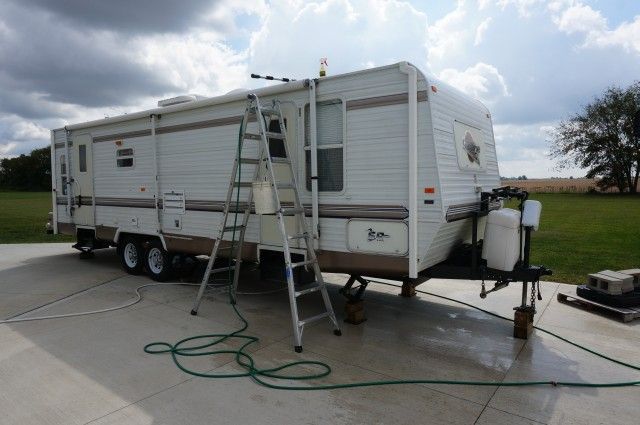
The washing brush setup. The toothbrush is for cleaning the crud out of the gutter.
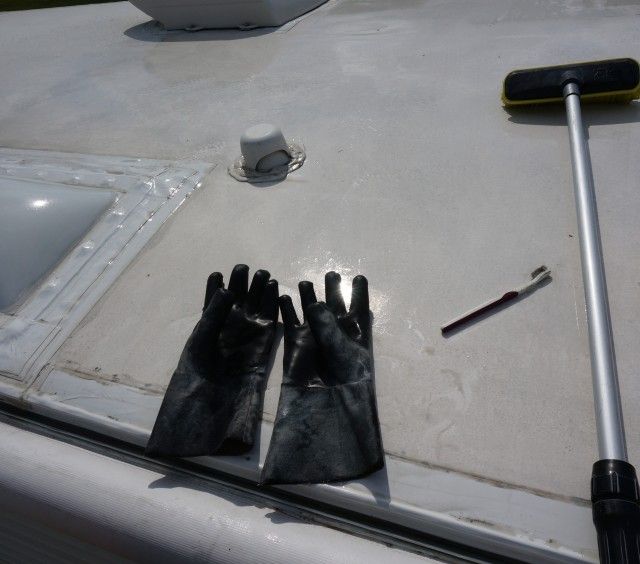
The 303 applicator. A car wax mop on a pole and 303 in a squirt bottle.
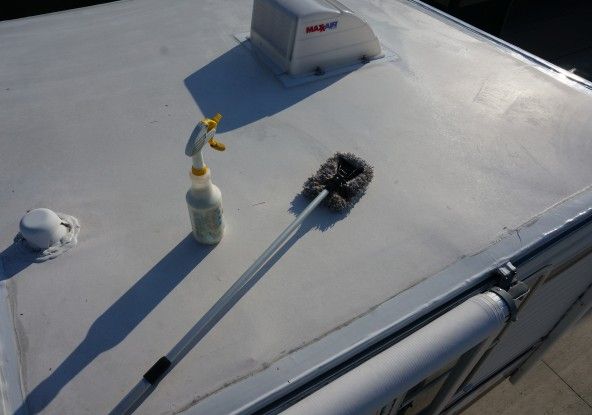
We really should not be comparing commercial rubber roofing to an RV roof. The actual water barrier on the Dicor rubber roof of 2003 and 2017 is 0.016". That is not much. It is slightly more then 2 and 1/2 sheets of some printer paper. The largest part of the layer makeup is the white layer. And the makeup of the white layer on an RV roof may be very different then a commercial roof.
Remember the RV industry is after something that just works, is ultra low cost and will just get past the warranty period. The entire camper is only designed to last so long. Dicor filled the need the RV industry was asking for. You do not really seeing Dicor Brite Ply EPDM being put on houses or buildings are you? (at least by mfg recommendation...) The first thing the lady at Dicor said to me, Oh the commercial roofing materiel is very different, it is much thicker. It's different. The entire white layer of and RV roof may be made from very different material then the commercial roof the black layer too. Do you think the RV roof is made the exact same way as the commercial roof? If so how did you come to this conclusion?
Thanks
John
- Mark as New
- Bookmark
- Subscribe
- Mute
- Subscribe to RSS Feed
- Permalink
- Report Inappropriate Content
Oct-18-2017 05:04 AM
- Mark as New
- Bookmark
- Subscribe
- Mute
- Subscribe to RSS Feed
- Permalink
- Report Inappropriate Content
Oct-18-2017 02:46 AM
Dicor obviously saw a business opportunity, and created a line of roof cleaning products. Which they now naturally strongly recommend.
As for different thicknesses. That may now be the case. But it doesn't change much.
Likely the RV manufacturers asked for lighter material so they could reduce the weight of their units.
Carlise says that the white material CAN be washed. Only to retain the reflectitiy of the material. But there is NO warranty requirement for it. AND the black material has NO washing recommendations.
For those that want to wash your roof.. My recommendation stays the same. If it makes you feel good, do it. So long as it is done right,
it won't hurt a thing....
But since I became the Safety Coordinator at my job about 5 years ago.... I must caution people on the dangers of doing so. A wet roof can be VERY slippery! The only safe way to do it would be with a catwalk scaffold system. Some dealers may have such a system. I know the manufacturer does, as I have seen it.
A fall to the ground can SERIOUSLY cripple or kill.
Be careful up there.
100% boondocking
2021 Grand Design Momentum 398M
2 bathrooms, no waiting
104 gal grey, 104 black,158 fresh
FullBodyPaint, 3,8Kaxles, DiscBrakes
17.5LRH commercial tires
1860watts solar,800 AH Battleborn batterys
2020 Silverado HighCountry CC DA 4X4 DRW
- Mark as New
- Bookmark
- Subscribe
- Mute
- Subscribe to RSS Feed
- Permalink
- Report Inappropriate Content
Oct-17-2017 09:30 PM
LarryJM wrote:
John,
As I said if one is to do any routine maintenance on an EDPM roof then your 4x a year especially using the 303 is IMO probably the one that I will concede is probably the best you can do and will actually extend the life of an EDPM roof.
IIRC an application of 303 lasts on the order of 1 to 3 months so at 4x a year you are IMO getting 95% of the benefit of using that and even simply slapping in over even a dirty EDPM roof might be just as effective as cleaning it first and then applying 303, but we won't really know and in the end it's not that important since what you do I readily admit works and I can see why.
However, you IMO are the exception to the rule on maintaining an RV in general and your roof maintenance just further demonstrates that and 99% of the folks out there would not do what you have done, nor keep their RV long enough to actually see any end benefit.
Of course we can't really tell, but even the roof with all those spider cracks while looking bad are still IMO full serviceable and might last another 10 to 15 years before the membrane would actually need to be replaced and getting 15 to 25 years service out of an EDPM roof should satisify any normal persons expectations and/or requirements.
I haven't actually done it, but it would not surprise me if you use upwards of 1 1/2 gal of 303 a year doing an application 4 times per year and at $50/gal over 10 years thats close to $750 in 303 alone which is almost the cost of a new membrane less installation where all the roof replacement cost is admittedly.
Larry
Hi Larry,
Thanks for the good words on taking care of the camper. And having one long enough to even get data like this... I'm humbled!
I have been helping folks with 10 plus year old campers lately. Not everyone buys new ones. And some folks may actually want to keep their campers a long time. They sure do not build them like they use too. I agree that the number of folks that do nothing at all on their roof is way too high. Come 6 to 10 years of doing nothing and the leaks are already in it. Yes this is from the caulking but my post was to help show, cleaning can enhance the life of the roof, not damage it.
The spider cracks is a fallout I believe from UV rays. By my using the 303, I warded off those cracks. Some cracks are small, some very large where you can see the black layer below it. To me, is a not good thing to have the spider cracks. If the white layer helps in retarding the UV attack on the black layer, anything to slow down the degradation of the white layer helps. And lets not go there that cleaning is killing the white layer. See the post above. If you follow the Dicor method, you can clean the roof and not kill the white layer.
I agree the white layer cracks are not affecting the membrane from leaking directly. The black layer is the water seal but the black left exposed will then start to break down more, IMO. If you have worn off the white layer enough the black layer is showing up, then a recoating needs to be done to build back up the white layer.
I'm not with you on putting 303 over the top of dirt. They will make the dirt situation of abrasiveness worse. It will be like bonding layers of new 3 months dirt on top of each other. My gosh the black streaks could take on new meaning... and the dirt could accumulate more... Putting 303 on a clean roof really helps the dirt fall off for a period of time. Remember you put those nice fancy rain guard flaps on to help on the black streaks and keep water off beating on the camper. Smart move!!!
I use a little less then 1 qt of 303 per roof treatment and that is everything up there not only the rubber. That is 1 gallon a year, $50 bucks in 4 treatments. I saw 3 months on the reapply instructions, I did not notice the 1 month thing. Spending $700 in 303 over 14 years is still cheaper then a new roof.
I have done total roof replacements, the material is $768 plus 246 work hours for a 27 foot camper with a walk on EPDM roof. That also included rebuilding the rear and front wall wood rot so the roof only is somewhat less labor. You pick what ever dollar per hour you want on the labor. A roof replace is not cheap. I can link the repair if wanted. It comes down to, if you cannot do the labor yourself, sell the camper the repair cost may be more then the camper. Point being, maintain the roof it is cheaper then replacing the roof.
I know I'm most likely not going to change ones mind on cleaning a roof if folks are in the camp of, don't clean the roof. OK, it's their roof, do as you please. Just like I'm not going to change what I do. Maybe though some folks who really do not know what to do, might think about this more and make a call that fits them. Hopefully they learn you have to maintain your RV rubber roof every year on a periodic basis or else the camper will die a death of water infection.
Thanks
John
- Mark as New
- Bookmark
- Subscribe
- Mute
- Subscribe to RSS Feed
- Permalink
- Report Inappropriate Content
Oct-17-2017 08:55 PM
We have been out camping and just catching back up on this roof cleaning topic.
It seems there is an opinion that washing the roof is a waste of time, it does not need to be done or is actually damaging to the roof. This conflicts with what I have found.
I asked this question a number of replies ago about if anyone found a manufacture or a rubber “camper” roof that stated to not wash the roof as it would damage the roof? As of today no one yet has been able speak to a brand that says that nor link to it. Maybe it will come yet.
JBarca wrote:
Hi, trying to learn about how you came to learning this.
I'm not following this thought process. Have you found a manufacture of a rubber roof membrane that has stated to not "clean" the roof? If so, please link their instructions that state this. May learn something new from it.
Dicor is who made my EPDM roof. Read all of it including the UV protectent at the end. This is their recommendation. Dicor EPDM Rubber Roofing Care
I took Huntingdogs lead and did some reading on the Carlise roofing site. They make commercial buildings rubber roofs. These types of rubber roofs seem to be different then the RV camper rubber roof. First off, they offer black rubber and white rubber pending what state you live in as buildings in cool climates can benefit from the added heat to the building from using black rubber. White rubber is used in hotter climates as the added heat load becomes a problem with the air conditioning. They also make many different grades and thickness along with warranty periods. Some commercial rubber roofs can have a 30 year warranty, others are 5 year. Point is, they are not all equal and have special purposes of the rubber material. Do not assume all rubber roofs are created equal.
Somehow, it seems some folks think these commercial rubber roofs are just like a camper rubber roof. I’m sure there are some similarities but I would not go as far as thinking they are the same.
Keeping an open mind, I did some more digging and ended up calling Dicor direct to confirm some things. Again, this is for my EPDM rubber roof made to Dicor specifications. I do not know what brand or type you have.
My camper was built in Nov, 2003. Here is a copy out of my owners manual. A cut sheet from Dicor on what they declare is proper maintenance to the roof. This was 14 years ago.
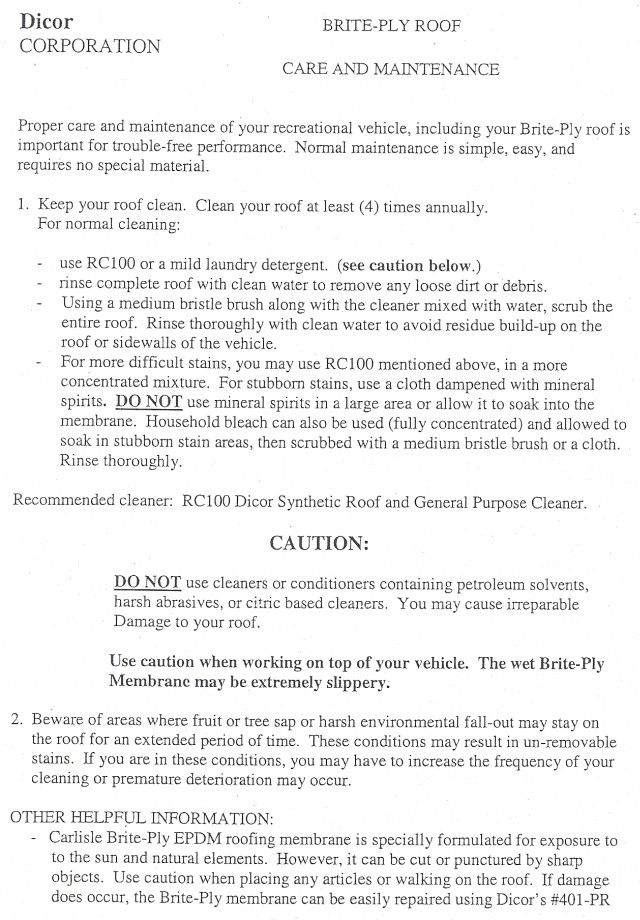
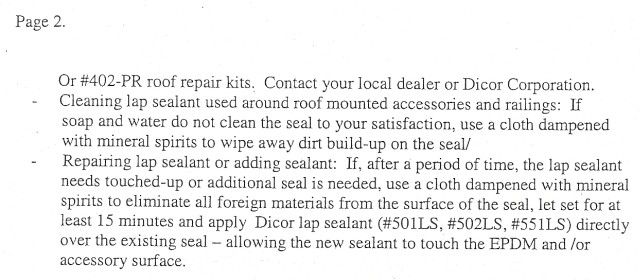
That recommendation 14 years ago in my owners manual aligns with the same instructions found today on the Dicor web site. They declare proper care is needed for the roof to be in warranty which is 12 years and they state the roof is good for 20 years if proper care is done that they recommend.
So I have been following their recommendation for 14 years using laundry soap with a medium bristle brush and washing the roof 3 to 4 times a year. I myself added the 303 UV protectant treatment that is now is part of the web site care instructions that states using a UV inhibiter is acceptable. The instructions also talk to bleaching if needed to remove mold.
My camper has aluminum siding. It also has a coating to make it more scratch and dent resistant called Krystal Kote. Some brands of campers use it, some don’t. I find it really helps on the dents and scratches and even helps against hail damage as compared to non coated siding.
I also know that when my roof gets dirty, the black streaks start getting really bad. And cleaning the camper is tedious getting rid of them. There is a definite difference in cleaning fiberglass sided camper then an aluminum camper. The Krystal Kote siding may even make it a little worse than plain aluminum siding as the coating has small pockets of holes and the black streaks get locked in those holes. If I did not clean my roof, the upkeep of cleaning the black streaks off the camper sides is a lot worse. It is a reason that aligns to keep the roof clean.
I have replaced and repaired enough Dirco roofs on other campers to have a few samples of virgin roof material. This Dicor rubber is 0.040” total thickness. It is made up of approximately a 0.016” black layer bonded to a 0.024” white layer. I sanded on a belt sander the white layer to just touch the black layer and measured it. Yes, I had to sand it off it is not that easy to get off. See here. There is some error in this but this gives us the big picture of the make up.
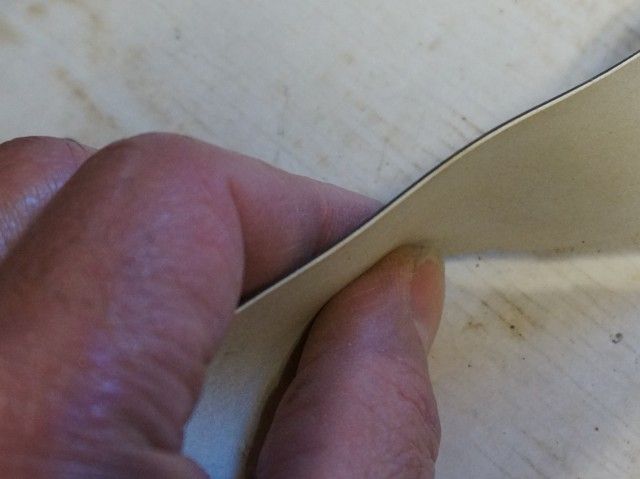
0.040" total thickness
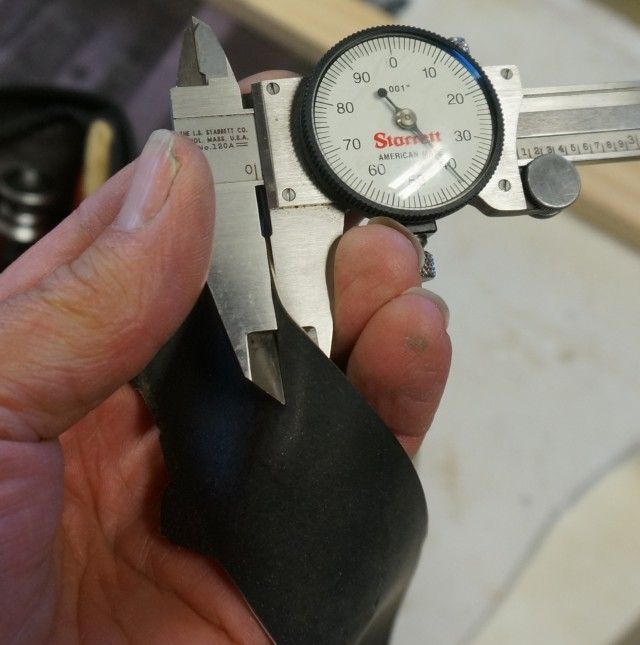
0.016" approx. black layer thickness. I sanded 2 spots to get an average of the black layer thickness.
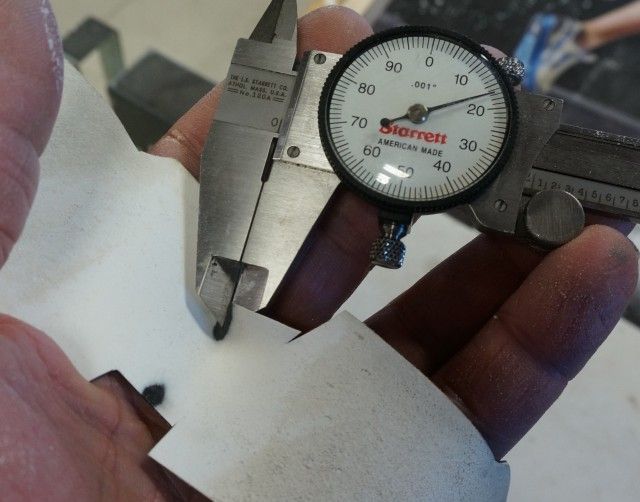

I believe the actual waterproof barrier is the black layer. The white layer is about reflectivity and being a UV protector to the black layer. The camper roof has 0.016” thick black material. Not very much. As a comparison to commercial roofing, the all black rubber membranes are much thicker, 0.045 and 0.060 are some and they have longer warranties too. https://www.carlislesyntec.com/view.aspx?mode=media&contentID=1183
The white covered EPDM, I do not know the layer make up only the total thickness. Some are 0.060” and some are 0.090” https://www.carlislesyntec.com/view.aspx?mode=media&contentID=1179
According to the commercial maintenance and care instructions Carlisle recommends to clean the white EPDM every 2 years with mild detergent to maximize reflectivity. https://www.carlislesyntec.com/view.aspx?mode=media&contentID=1127
Bottom line, the commercial EPDM rubber roofs are different then an RV camper EPDM rubber roof. Why are folks comparing them to be the same?
My call to Dicor Products confirmed, they want you to clean the roof. They state 4 times a year using the method and cleaning materials they recommend. They stated the dirt on the surface changes the reflectivity of the roofing. A dirty roof also makes it harder to inspect the caulking accurately. I tried to get more out of them about if cleaning was a bad thing and they responded several times, follow the care instructions as they have posted. You are not damaging the roof by following their instructions.
I asked about the warranty and if the care instructions of cleaning were not followed would this affect the 12 year warranty? The answer was yes, not following the care instructions can have a negative effect on accepting a warranty claim.
So in writing, across at least the last 14 years, Dicor wants you to clean the roof by using their method. So where does all this talk of doing damage to your Dicor Brite Ply EPDM rubber roof come from by cleaning it?
RV’ing is about choices as has been said. You can choose to follow the manufactures recommendations about their products to meet their warranty or you can chose something else. Your choice.
So I chose to follow the instructions and post my 14 year data, maybe it might help you, maybe not. I hoped it was helpful.
Thanks
John
- Mark as New
- Bookmark
- Subscribe
- Mute
- Subscribe to RSS Feed
- Permalink
- Report Inappropriate Content
Oct-13-2017 07:20 AM
I have researched this washing of roofs extensively over the last 10-12 years. Some facts. The warranty on EDPM roofs is often quoted as a "manufacturers warranty". Most assume that is Dicor. It is not. Dicor buys it from Carlise who IS the manufacturer. Dicor originally frowned on the washing of roofs. In fact it used to be in their FAQ section on their website. The following is a post I made on this subject back in 2008. I just went to the Dicor website. It's been quite a few years since I've visited that site. Back then I remember they had a freqently asked questions section, and you guessed it, "How to wash the rv roof" was one of the top subjects! At that time Dicor basically poo, pooed the idea. They had explicit warnings on how the wrong substances could damage the roof. They did say that it could be washed with care using a select product(s). I can't remember what was recommended. Now the Dicor site has a new attitude towards washing roofs! It seems that they realized that their was a huge demand for a safe product to use for roof washing, and thus a buissiness opportunity !! They now SELL roof washing products! They have also changed their recomendation and now say to wash the roof 4 times a year! A deeper look and the ability to read between the lines will reveal the truth. Dicor says that Carlisle (UH OH, How many roof blowout stories will we hear now?!!) makes the membrane for them to their specification. Now I seriously doubt that the actual composition of the material is any different than the HUGE commercial roofing market that Carlise serves. I bet the main specification is that the Dicor material comes in rolls the width necessary to roof RVs! A visit to the Carlisle site is also enlightening. They have their maintenence and warranty brochures for their roofing products online. The only washing recomended is that the white EDPM be washed every 2 years! And that is only to keep the reflectivity of the white material from degrading due to excess dirt! The black EDPM has no washing recommendations. Both of the EDPM products have cautions about foot traffic. If you go to this site, notice the changing pictures on the home page. One of them shows a roof that is alive,,,with grass and other vegetation. That rings a bell with me as I have read articles on these kinds of roofs and remembered that under all that soil and plant life is an EDPM membrane to keep the water out of the structure. So much for the theory of a little dirt etc. hurting the membrane. I don't wash my roof. I'd rather spend my time doing something fun like camping! My old 2001 TT was washed once right before I sold it. I never washed the roof. It cleaned up nicely and really impressed it's new owner. It sold incredibly fast for my asking price and had a backup buyer waiting for a chance at it. If one wants to wash their roof, go right ahead. It won't hurt anything (if done right) but their is no reason to other than looks.
100% boondocking
2021 Grand Design Momentum 398M
2 bathrooms, no waiting
104 gal grey, 104 black,158 fresh
FullBodyPaint, 3,8Kaxles, DiscBrakes
17.5LRH commercial tires
1860watts solar,800 AH Battleborn batterys
2020 Silverado HighCountry CC DA 4X4 DRW
- Mark as New
- Bookmark
- Subscribe
- Mute
- Subscribe to RSS Feed
- Permalink
- Report Inappropriate Content
Oct-13-2017 07:11 AM
And comparing different TTs really hard to do, as they have all been exposed to different conditions.
100% boondocking
2021 Grand Design Momentum 398M
2 bathrooms, no waiting
104 gal grey, 104 black,158 fresh
FullBodyPaint, 3,8Kaxles, DiscBrakes
17.5LRH commercial tires
1860watts solar,800 AH Battleborn batterys
2020 Silverado HighCountry CC DA 4X4 DRW
- Mark as New
- Bookmark
- Subscribe
- Mute
- Subscribe to RSS Feed
- Permalink
- Report Inappropriate Content
Oct-13-2017 05:53 AM
LarryJM wrote:nextlevel wrote:
Good morning everyone. I am having trouble getting my epdm roof clean. I bought this 2011 Puma back in July and I don't think the previous owner ever cleaned the roof. I am presently using Lucas #115 as a cleaner but after cleaning I can still rub my hand across the rubber and white stuff comes off. Any advice?
Yea LEAVE IT ALONE ... that white stuff is the normal deterioration of the protective layer which helps provide more protection as a somewhat sacrificial layer if left alone. By trying to remove it which BTW is going to be virtually impossible you are IMO actually SHORTENING THE LIFE of your roof.
LEAVE YOUR ROOF ALONE and GO CAMPING:B:W
Larry
This is exactly correct. I just don't understand why people are obsessed about the cleanliness of their roof to the extent they actually damage it.
- Mark as New
- Bookmark
- Subscribe
- Mute
- Subscribe to RSS Feed
- Permalink
- Report Inappropriate Content
Oct-13-2017 05:50 AM
JBarca wrote:
The lack of roof maintenance really shows up on this camper. The caulking is in real bad shape. Splits and cracks in a lot of places that are deep. A classic of what happens when you do not do roof maintenance.
.....
Thoughts? What did I miss that tells me leaving the roof uncleaned and un UV treated is OK to do?
Thanks
John
The issue with your friends roof is the first piece that I quoted... caulking is in real bad shape. That is why her roof leaked, not because she didn't clean and condition it.
I sold my 1998 Nash a little over 2 years ago. It was never covered and the roof was never cleaned. When I bought it, I cleaned the edges where the caulk is and used Eternabond tape. The original Nash roof was 17 years old when I sold it and it was fine.
People that want their roof to look pretty can wash and polish and condition to their hearts desire... but I have seen no evidence that doing any of that makes your roof last one day longer. In fact, I remember reading literature that explains that the white coating is specifically designed to chalk off to extend the longevity of the roof. By washing and rubbing off that rough chalked off surface, you are removing the designed feature that extends the life.
Your camper, your choice. I'd rather spend that money on fuel to go camping more and spend that time camping more. EdAtlanta is the only person that I have ever heard of that had a rubber roof failure... ever. Every other roof failure or leak that I have ever seen or heard has been due to improper maintenance of caulked joints or deteriorated plastic pieces on the roof.
2015 Jayco 29QBS
- Mark as New
- Bookmark
- Subscribe
- Mute
- Subscribe to RSS Feed
- Permalink
- Report Inappropriate Content
Oct-13-2017 12:43 AM
As I said if one is to do any routine maintenance on an EDPM roof then your 4x a year especially using the 303 is IMO probably the one that I will concede is probably the best you can do and will actually extend the life of an EDPM roof. IIRC an application of 303 lasts on the order of 1 to 3 months so at 4x a year you are IMO getting 95% of the benefit of using that and even simply slapping in over even a dirty EDPM roof might be just as effective as cleaning it first and then applying 303, but we won't really know and in the end it's not that important since what you do I readily admit works and I can see why. However, you IMO are the exception to the rule on maintaining an RV in general and your roof maintenance just further demonstrates that and 99% of the folks out there would not do what you have done, nor keep their RV long enough to actually see any end benefit. Of course we can't really tell, but even the roof with all those spider cracks while looking bad are still IMO full serviceable and might last another 10 to 15 years before the membrane would actually need to be replaced and getting 15 to 25 years service out of an EDPM roof should satisify any normal persons expectations and/or requirements. I haven't actually done it, but it would not surprise me if you use upwards of 1 1/2 gal of 303 a year doing an application 4 times per year and at $50/gal over 10 years thats close to $750 in 303 alone which is almost the cost of a new membrane less installation where all the roof replacement cost is admittedly.
Larry
RAINKAP INSTALL////ETERNABOND INSTALL
- Mark as New
- Bookmark
- Subscribe
- Mute
- Subscribe to RSS Feed
- Permalink
- Report Inappropriate Content
Oct-12-2017 06:16 PM
Do you EVER see commercial rubber roofs of any kind, being cleaned?
I grew up in a home with two rubber roof's over a front and back "breeze way". Did anyone ever clean them? LOL. Of course not. And both rubber roofs lasted LONGER than the asphalt shingles did, twice in my life time.
Just inspect sealant around components and roof edges...that's about it.
- Mark as New
- Bookmark
- Subscribe
- Mute
- Subscribe to RSS Feed
- Permalink
- Report Inappropriate Content
Oct-12-2017 06:07 PM
LarryJM wrote:
I'm a big believer in 303 and use it extensively and buy it by the gallon and IMO it is the ONE ITEM worth using to extend anything made of rubber or plastic that lives outside. The one biggest drawback is that it doesn't last very long and would agree with you that if you expend the time, effort and $$$ to simply apply it 4 times a year that will extend and preserve an EDPM roof significantly.
I still would not clean it, but can't disagree too much with your apparantly very reasonable cleaning and 303 application. Question is the time and effort one has to spend performing such a dedicated and frequent maintenance plan. I doubt there is more than maybe 1 in 20 that do what you do 4X a year and if the interval is extended to say 6 or 9 months then I still think one can do more harm than good trying to extend the life of an EDPM roof by cleaning it.
However simply dumping 303 even on a dirty roof can't hurt it either, but unless you do it like you do 4x or more a year I question how much longer an EDPM roof will actually last over one not maintained. Looks like the spider web cracking I'm not so sure how significant that is to the overall life of the roof. Maybe it only lasts 15 vice 20+ years I'm not sure.
My roof is not 11 years old (built in June of 2006) and I have cleaned it ONCE back in the spring of 2008 just prior to my massive Eternabonding extravaganza and it is not showing the type of issues your 2003 unit is and mine has live outside 24/7 in the NoVa weather (just outside of D.C.) that entire time except for the year or so it has been on the road, mostly to Florida/Mississippi.
Larry
Hi Larry,
Let's compare notes. I remember well when you started your Eternabonding extravaganza on your new camper. You inspired me! I did my entire roof with the exception of 2 tank vent covers in 2010 and I'm really glad I did. I just could not trust the caulking from not developing a leak over the winter and the E bond did the trick. But there is a learning from this too. I'm open minded to listen and learn, but see here what I have found and let's compare to what you have found.
I'll try to show this in pics across several campers I have worked on over the last 2 years and where I can drawing my conclusions from.
First here is my current camper. As I said, it was born in Nov 2003 and it lived outside until August 2013 when the new barn came. I have been washing the dirt with Tide and doing a demold process approx every 3 to 4 years as needed. Each cleaning is followed by a 303 UV treatment. Cleaning has been 3 to 4 times a year up until Aug 2013. Now that it inside whenever we are not camping, I have cut back to 2 to 3 times a year on the cleaning and 303 treatment.
Here is a total roof shot. This is now close to 14 years old.

The rubber surface is still smooth. There are no spider cracks or crystallization looks.
And more amazing, this vent cap has the original 2003 Dicor on it at on the original bottom seal to main roof. The upper application was from me along the way when small splits had just stated over the screws. I do not recall what year I added that Dicor on top. The point I'm showing here is the 303 UV treatment is the only explanation I have for why that Dicor is that good. That and the washing/demolding maybe?

Now lets change to a camper I just repaired for a friend. She bought this 2005 camper this spring and it has 2 roof area leaks. One front left corner and one rear right corner. This roof has had almost no care for it. No cleaning and for sure no 303 UV treatment. The rubber white layer has spider cracks and a crystallization in it. I can't seem to get a good closeup to show this.
Here is what I started with. The rear right leak area
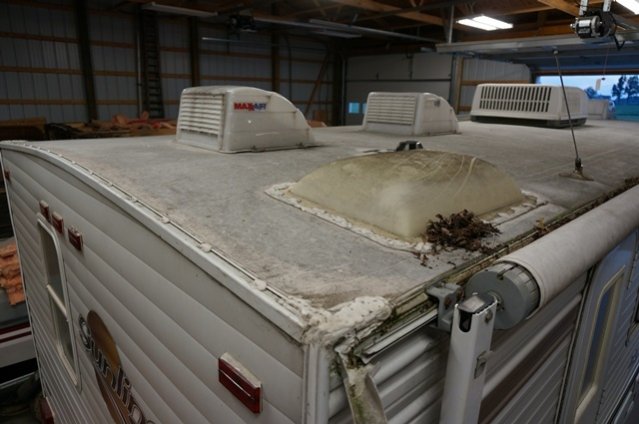
The front left leak area
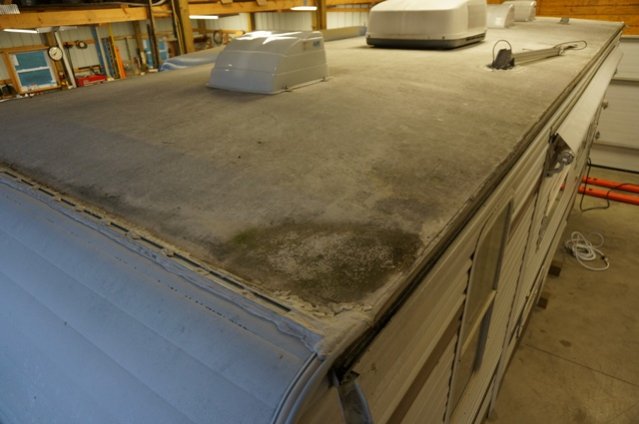
The lack of roof maintenance really shows up on this camper. The caulking is in real bad shape. Splits and cracks in a lot of places that are deep. A classic of what happens when you do not do roof maintenance.
Here is a close up of the rubber and the Dicor on the gutter area. The pics does not show the spider cracks and the crystallization that I can see by eye.
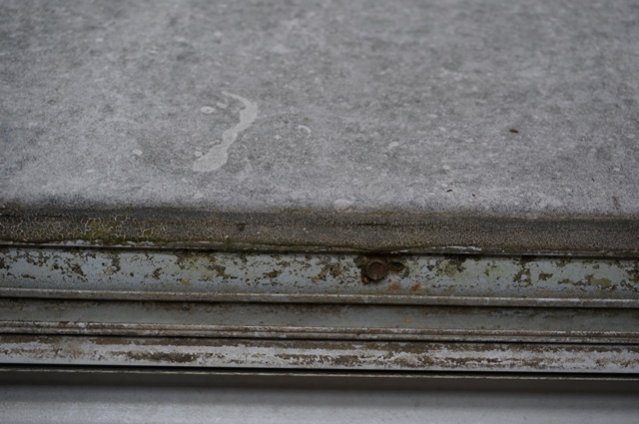
Here is an attempt to show the spidering/crystallization
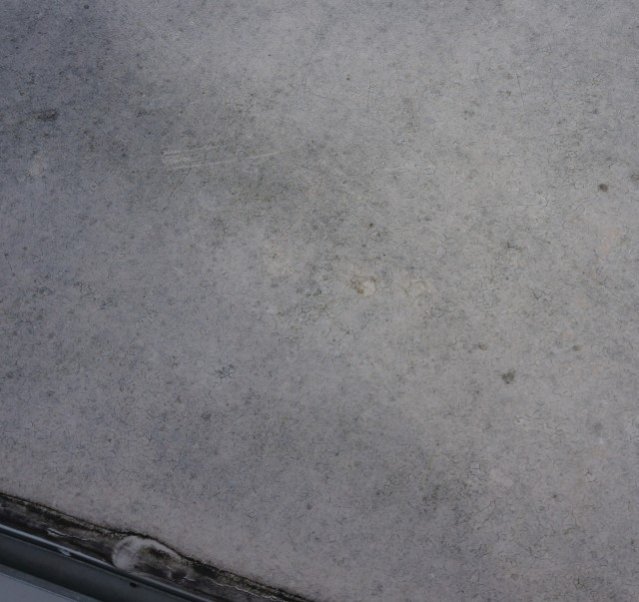
a close up zoomed in

After I repaired the front leak, and the back wall and 2 sides and the back of the roof, I went to washing the roof before the final caulking. I needed to redo almost all the caulking. After washing I saw that I needed to peel up much of the Dicor as the cracks in the caulk was too far advanced.
The dirt was embedded into the rubber. The mold was bad too and I do not know if it contributed to the holding the dirt into the rubber. To me, this is roof abuse from lack of proper maintenance. While the rubber is not leaking, I'll show here in a moment deterioration of the white layer.
Here I am on the first Tide treatment cleaning on the main roof. The edges you see white as from the repair process and a chemical clean before putting down new butyl
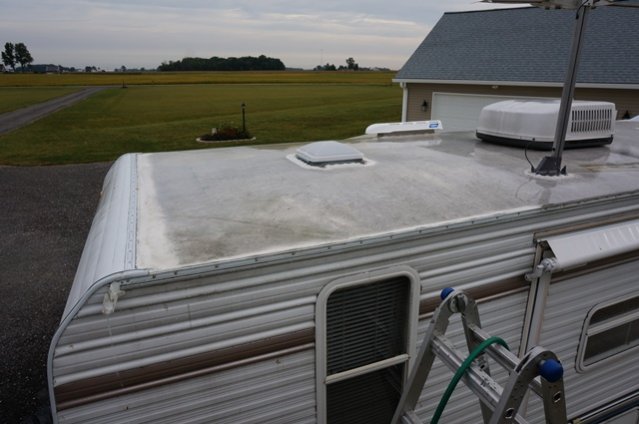
The brush just about stalled trying to push it. It was like washing 80 to 100 grit sand paper. I had to do the tide treatment twice, then I had to do 2, demolding steps to get the roof back to clean. Then I 303 UV treated it after the final caulking. Here it is with the final caulking and ready to leave my place. It took me 3.5 hours non stop to get it to this point in cleaning alone.
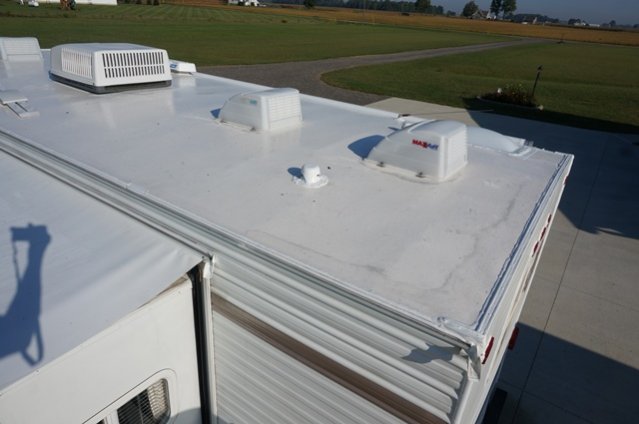
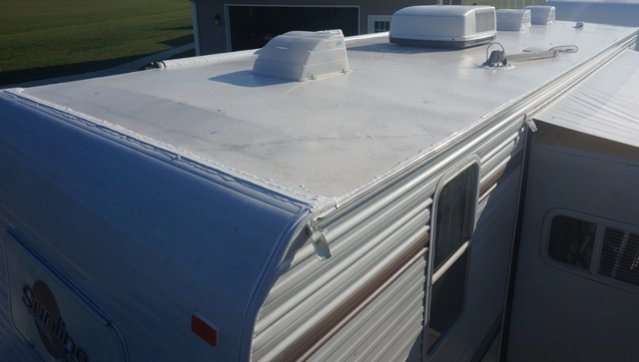
You can still see some staining lines, but they are not concerning me as they are discolored and not dirt.
Here are a few pics that really shocked me. It is the loss of the white layer. I can measure it. The entire exposed roof has lost a good percentage of the white layer. This is before I washed it and remember this roof has not been washed very much if ever. The nice white strip is the main roof that was under the rear seam molding. The molding protected the white layer from the sun and the dirt.
See here
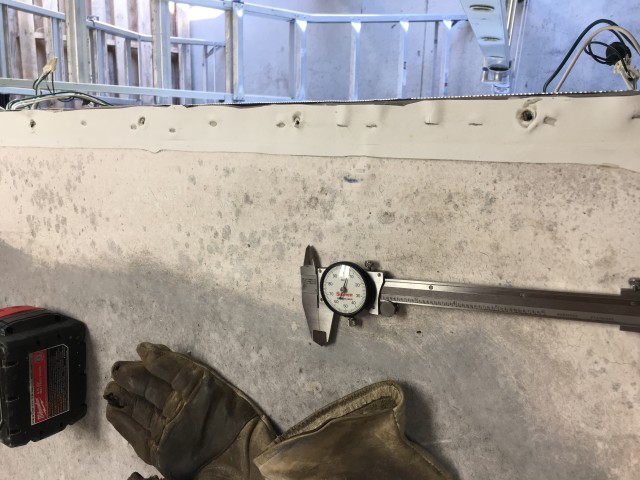
A close up. You can see the spider cracks

Now measuring it. There is a small amount of error in measuring rubber but this gives us the big picture.
0.012" loss

0.018" loss

0.028" loss
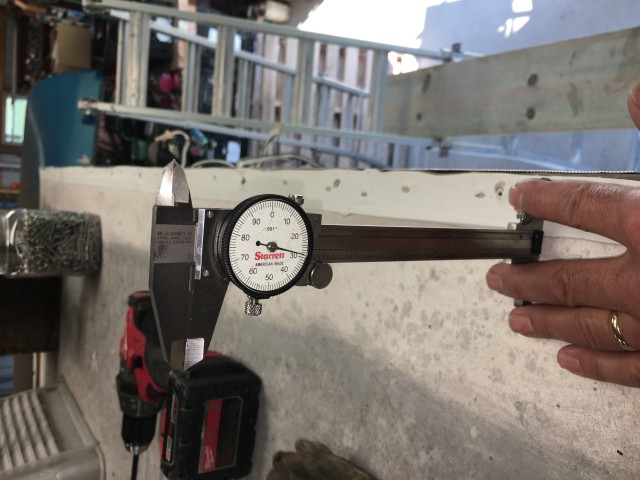
We have between 0.012 to 0.028" loss range. It is not even loss. This loss did not come from washing the roof. It came from deterioration of being exposed to the conditions.
Here is another friend of mine camper that just bought a 10 year old camper and the roof has been neglected. Very little to no washing and no prior caulking other then what the dealer did a month ago before he bought it
And his spidering. He lives in VA. You can see the black rubber at the bottom of the cracking after he washed the roof.
I have 2 more campers I can show which have the same spidering and crystallization. My 2004 project camper and my son's 2006 camper. On my son's we replaced the entire roof membrane. On my 2004 project camper, I am in the process of repair and will replace the entire membrane.
Point I'm making in this, my current camper is 14 year old and the roof is smooth, clean and no crystallization. The roof is washed and UV treated. There are 4 others of the same EPDM brand and build that are newer and have had the roof washed very little if ever and odds are high, never saw 303 UV treatment. The results are very different. From this, I'm from the thought process, cleaning the dirt, keeping he mold in check and 303 UV treatment is a good thing.
Thoughts? What did I miss that tells me leaving the roof uncleaned and un UV treated is OK to do?
Thanks
John
- Mark as New
- Bookmark
- Subscribe
- Mute
- Subscribe to RSS Feed
- Permalink
- Report Inappropriate Content
Oct-11-2017 02:53 PM
JBarca wrote:ScottG wrote:LarryJM wrote:nextlevel wrote:
Good morning everyone. I am having trouble getting my epdm roof clean. I bought this 2011 Puma back in July and I don't think the previous owner ever cleaned the roof. I am presently using Lucas #115 as a cleaner but after cleaning I can still rub my hand across the rubber and white stuff comes off. Any advice?
Yea LEAVE IT ALONE ... that white stuff is the normal deterioration of the protective layer which helps provide more protection as a somewhat sacrificial layer if left alone. By trying to remove it which BTW is going to be virtually impossible you are IMO actually SHORTENING THE LIFE of your roof.
LEAVE YOUR ROOF ALONE and GO CAMPING:B:W
Larry
X2,
Your roof never "needs" to be cleaned except for your own asthetic reasons. The more you clean it the more you remove that protective white coating. It does nothing healthy for the roof to clean it.
The best thing you can do is inspect the caulking and otherwise leave it alone.
Hi, trying to learn about how you came to learning this.
I'm not following this thought process. Have you found a manufacture of a rubber roof membrane that has stated to not "clean" the roof? If so, please link their instructions that state this. May learn something new from it.
Dicor is who made my EPDM roof. Read all of it including the UV protectent at the end. This is their recommendation. Dicor EPDM Rubber Roofing Care
My camper was built in Nov. 2003 and is close to being 14 years old. For the first 10 years, the camper lived outside 365 days a year in Central Ohio through snowing winters. It now lives in a pole barn since 2013.
I wash the roof with Tide laundry detergent to get the dirt off. Once dry, I apply 303 UV protectant to the rubber and all plastic or Dicor caulking on the roof. This process is done 3 to 4 times a year. Once always before winter and once always comeing out of winter and a time or 2 in the warmer weather.
Due to my area, mold grows quickly. About every 3 to 4 years I need to do a mold removal on the roof to keep it in check. The Tide cuts the dirt but not the mold. The Dicor instructions tell how to do this that I linked above.
My roof today is still in perfect shape. There is very little deterioration of the white layer and there are no fine or large cracks in the rubber membrane white layer.
I also acquired a project camper this spring. It was built in Oct 2003. It is only 1 month older then my current camper in my sig. It is the same brand I have now, but it had a leak, a bad one. I am rebuilding it. This roof never had any attention to it. The Dicor caulking is toast, the rubber is toast, the dirt is deeply embedded into the rubber and spider cracks exist in the rubber membrane white layer. Everything plastic on the roof is shot. This camper lived 3.5 hours from where I have had mine stored outside. Same state, with very similar winter conditions as well as moist spring and summer as well as the years the roof has been on.
The difference between the 2 campers roofs is dramatic. One has been taken care of, the other not. The outcome is very different. Granted this is for living in Central Ohio. Other states may produce a different outcome. I'm sure AZ, FL and TX will be different then a northern state.
The more I help others with a 10 plus year old rubber roof camper where the prior owner did nothing for the roof, the outcome is not good. The rubber itself is cracked in the white layer like it was a piece of glass with fine and large lines going all over. The more I learn about how bad a neglected roof turns out in 10 years, the more I am convinced that using 303 UV protectant on the rubber and the caulking makes a significant difference in the lasting of the roof system. Proper cleaning is also part of this. The caulking is still a weak link in this roof system but even the Dicor will benefit from the added UV protection. In 2010 I did a full Eternabond treatment
to deal with the caulking splits that come over the winter.
I never would of known how much my care regiment on the EPDM roof has helped until I have had to help several others repair their failing 10 year old roof system. That and the project camper I acquired this spring.
My vote, care for the rubber roof like your manufacture states and consider a UV protectant.
Hope this helps
John
I'm a big believer in 303 and use it extensively and buy it by the gallon and IMO it is the ONE ITEM worth using to extend anything made of rubber or plastic that lives outside. The one biggest drawback is that it doesn't last very long and would agree with you that if you expend the time, effort and $$$ to simply apply it 4 times a year that will extend and preserve an EDPM roof significantly. I still would not clean it, but can't disagree too much with your apparantly very reasonable cleaning and 303 application. Question is the time and effort one has to spend performing such a dedicated and frequent maintenance plan. I doubt there is more than maybe 1 in 20 that do what you do 4X a year and if the interval is extended to say 6 or 9 months then I still think one can do more harm than good trying to extend the life of an EDPM roof by cleaning it. However simply dumping 303 even on a dirty roof can't hurt it either, but unless you do it like you do 4x or more a year I question how much longer an EDPM roof will actually last over one not maintained. Looks like the spider web cracking I'm not so sure how significant that is to the overall life of the roof. Maybe it only lasts 15 vice 20+ years I'm not sure.
My roof is not 11 years old (built in June of 2006) and I have cleaned it ONCE back in the spring of 2008 just prior to my massive Eternabonding extravaganza and it is not showing the type of issues your 2003 unit is and mine has live outside 24/7 in the NoVa weather (just outside of D.C.) that entire time except for the year or so it has been on the road, mostly to Florida/Mississippi.
Larry
RAINKAP INSTALL////ETERNABOND INSTALL





